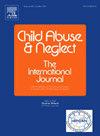Predictor importance of organizational factors of burnout in child welfare workers
IF 3.4
2区 心理学
Q1 FAMILY STUDIES
引用次数: 0
Abstract
Background
The prevalence and predictors of work-related burnout have been extensively investigated within the child welfare workforce. However, the understanding of significant predictors has largely relied on traditional regression analyses, which often fail to capture the unique contributions of each predictor. Dominance analysis (DA) is an advanced quantitative method that determines the relative importance of predictive variables in multiple regression models.
Objective
This study aimed to determine which empirically-based predictor had the most impact on work-related burnout in child welfare workers.
Participants and setting
This study used a sample of newly hired frontline child welfare workers (n = 597) who had been on the job for 18 months.
Methods
A DA was used to analyze a regression model of eight empirically based predictors of work-related burnout in child welfare workers.
Results
Findings among frontline child welfare workers (n = 597) indicate that time pressure contributed the most unique variance (17 %) when predicting work-related burnout and dominated all other organizational factors predicting work-related burnout.
Conclusions
Findings have implications for child welfare organizations and child welfare workforce policy development.
组织因素对儿童福利工作者职业倦怠的预测作用
工作倦怠的患病率和预测因素已经在儿童福利工作人员中进行了广泛的调查。然而,对重要预测因子的理解在很大程度上依赖于传统的回归分析,这往往不能捕捉到每个预测因子的独特贡献。优势分析(DA)是一种先进的定量方法,用于确定多元回归模型中预测变量的相对重要性。目的探讨儿童福利工作者工作倦怠的影响因素。参与者和环境本研究使用了新雇佣的一线儿童福利工作者(n = 597)的样本,他们已经工作了18个月。方法采用数据分析方法对儿童福利工作者工作倦怠的8个实证预测因素进行回归分析。结果597名一线儿童福利工作者的调查结果显示,时间压力对工作倦怠的影响最大(17%),其他组织因素对工作倦怠的影响最大。结论研究结果对儿童福利机构和儿童福利劳动力政策的制定具有指导意义。
本文章由计算机程序翻译,如有差异,请以英文原文为准。
求助全文
约1分钟内获得全文
求助全文
来源期刊

Child Abuse & Neglect
Multiple-
CiteScore
7.40
自引率
10.40%
发文量
397
期刊介绍:
Official Publication of the International Society for Prevention of Child Abuse and Neglect. Child Abuse & Neglect The International Journal, provides an international, multidisciplinary forum on all aspects of child abuse and neglect, with special emphasis on prevention and treatment; the scope extends further to all those aspects of life which either favor or hinder child development. While contributions will primarily be from the fields of psychology, psychiatry, social work, medicine, nursing, law enforcement, legislature, education, and anthropology, the Journal encourages the concerned lay individual and child-oriented advocate organizations to contribute.
 求助内容:
求助内容: 应助结果提醒方式:
应助结果提醒方式:


